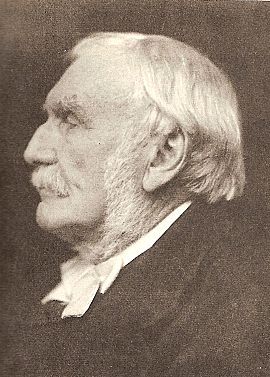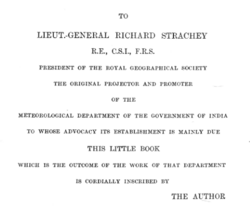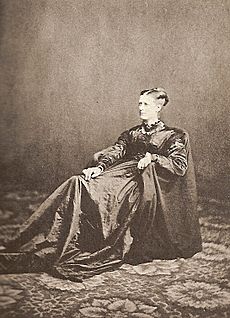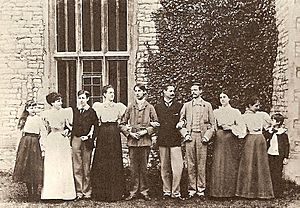Richard Strachey facts for kids
Quick facts for kids
Sir
Richard Strachey
|
|
|---|---|
 |
|
| President of the Royal Geographical Society | |
| In office 23 May 1887 – 27 May 1889 |
|
| Preceded by | The Marquess of Lorne |
| Succeeded by | Sir Mountstuart Duff |
| Personal details | |
| Born | 24 July 1817 Stowey, Somerset, England |
| Died | 12 February 1908 (aged 90) Camden, London, England |
| Spouse | Jane Maria Grant (1859–1908; his death) |
| Children | 13, including Lytton, James, Dorothea, Pernel, and Oliver |
| Parent |
|
| Military service | |
| Branch | |
| Rank | Lieutenant-general |
| Wars | First Anglo-Sikh War |
Sir Richard Strachey was an important British soldier and administrator who worked in India. He was born on July 24, 1817, and passed away on February 12, 1908. Richard Strachey came from a family deeply involved in Indian government. Many of his relatives worked there, so people sometimes joked about the "Government of the Stracheys."
Contents
Early Life and Education
Richard Strachey was born at Sutton Court in Stowey, Somerset, England. He joined the Bengal Engineers in 1836 after studying at Addiscombe Military Seminary. For several years, he worked on projects to bring water to farms in the North-Western Provinces of India. This was very important for growing crops.
Military and Exploration Work
Serving in the First Anglo-Sikh War
Strachey was a soldier in the First Anglo-Sikh War from 1845 to 1846. He fought in major battles like Aliwal and Sobraon. His bravery was noted, and he was promoted to a higher rank.
Exploring the Himalayas
In 1848, Richard Strachey, along with J. E. Winterbottom, explored parts of Tibet. They visited two large lakes, Manasarovar and Rakshastal. His brother, Henry Strachey, had visited these lakes two years earlier. In 1849, both brothers returned to Tibet through the Niti Pass.
Contributions to India's Development
Public Works and Irrigation
From 1858 to 1865, Strachey worked mostly in the public works department. He helped manage large building projects for the government of India. Later, from 1867 to 1871, he became the director-general of irrigation. This was a new role created just for him.
He helped to completely reorganize how public works were managed. This made sure that money was tracked properly and that forest management improved. His efforts were key to these important changes.
Financial Reforms in India
Richard Strachey also played a big part in improving India's finances. In 1867, he created a plan to give more financial control to local areas in India. This idea was later put into action by his brother, Sir John Strachey.
He returned to India in 1877 to discuss buying the East Indian Railway Company. He also led a group that looked into famines in India. In 1878, he suggested ways to deal with the falling value of the Indian currency, the rupee.
International Financial Meetings
In 1892, Strachey went to the International Monetary Conference in Brussels. He represented British India at this important meeting. He also served on the council for the Secretary of State for India from 1875 to 1889. After that, he became the chairman of the East Indian Railway Company.
Scientific Achievements

Strachey was very interested in science, especially the geology, botany, and physical geography of the Himalayas. He spent a lot of time studying the weather. He was a key person in setting up the Indian Meteorological Department, which studies weather patterns.
In 1883, he became the chairman of the meteorological council of the Royal Society. He was also the president of the Royal Geographical Society from 1888 to 1890. In 1897, he received a special award called the Royal Medal from the Royal Society. He also became a Knight Grand Commander of the Order of the Star of India (GCSI) that same year. He passed away on February 12, 1908.
Meteorological Research
Strachey's most important scientific work was in meteorology, the study of weather. He helped create the scientific study of Indian weather. The department he organized helped predict droughts and food shortages.
He was also good at math and loved inventing tools. He designed instruments to help understand weather data. For example, he created a "sine curve developer" in 1884. This tool showed weather information in a visual way. He also designed "slide rules" to help calculate weather patterns.
Another invention was a simple tool called a "nephoscope." This helped observe the direction of high clouds, which move very slowly.
Family Life
Richard Strachey first married Caroline Bowles, but she passed away in 1855, less than a year after their wedding.
In 1859, he married Jane Maria Grant. She was 18 and he was 42. Jane, Lady Strachey, later became a well-known writer and supported women's rights. She even helped lead a large protest march in London in 1907.
Sir Richard and Lady Strachey had thirteen children together. Ten of them lived to adulthood. Some of their notable children include:
- Dorothy Bussy (1865–1960), who was a writer.
- Pippa Strachey (1872–1968), who was a suffragist and feminist.
- Oliver Strachey (1874–1960), a writer and code-breaker who worked at Bletchley Park during WWII.
- Pernel Strachey (1876–1951), a scholar and educator who became the principal of Newnham College, Cambridge.
- Lytton Strachey (1880–1932), a famous writer known for books like Eminent Victorians.
- James Strachey (1887–1967), a psychoanalyst.
See also
- Strachey baronets
Other sources
 This article incorporates text from a publication now in the public domain: Vetch, Robert Hamilton (1901). "Strachey, Richard". Dictionary of National Biography (supplement) 3. Ed. Sidney Lee. London: Smith, Elder & Co.
This article incorporates text from a publication now in the public domain: Vetch, Robert Hamilton (1901). "Strachey, Richard". Dictionary of National Biography (supplement) 3. Ed. Sidney Lee. London: Smith, Elder & Co. - Sabyasachi Bhattacharya (2005) The Financial Foundations of the British Raj. Orient Longman. ISBN: 81-250-2903-6.
- Barbara Caine (2005) Bombay to Bloomsbury: A Biography of the Strachey Family. Oxford University Press. ISBN: 0-19-925034-0.



